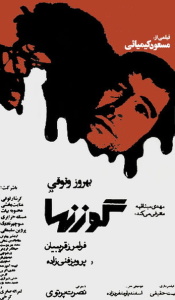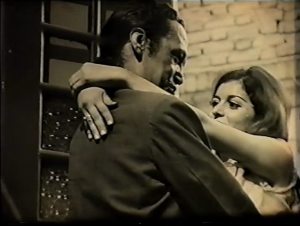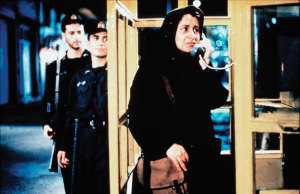By Amir Ganjavie.
Since March 5, Toronto International Film Festival’s screening programme, TIFF Cinematheque, has presented a series called “I for Iran: A History of Iranian Cinema by Its Creators”. According to its website, “Selected by fourteen top Iranian filmmakers, the films in this essential retrospective comprise a capsule history of one of the most distinguished national cinemas in the world.” The site argues that the program has been implemented with the goal of giving “Toronto audiences an invaluable opportunity to see these classics of world cinema on the big screen, the way they were meant to be seen.”
Those involved in preparing the I for Iran series deserve praise. Dr. Hamid Naficy, film professor at Northwestern University and guest speaker for the series, told me that due to the political embargo on Iran and the outdated cinematic infrastructure in Iran, it is very difficult to obtain many Iranian films and a festival sometimes needs to spend over a year searching the world for good-quality copies of some of these titles. One could agree well with Aref Mohammadi, a Toronto-based Iranian film critic, that TIFF’s attempts to show Iranian movies overall is a positive step that needs to be praised.
Having said this, reviewing the series gives one the feeling that the selection procedure prioritized politics – democracy over art – and the series consequently has very limited educational value. The resulting program is essentially the same as the one presented last year during the 2014 Fribourg International Film Festival in Switzerland. As indicated on the I for Iran website, “this series, expanded from its original iteration at the 2014 Fribourg International Film Festival.” As event programmer Brad Deane told me, “When the Fribourg International Film Festival approached us with the idea to host their series here in Toronto, we were thrilled to offer local audiences the opportunity to watch a small selection from the history of Iranian cinema on the big screen.” I agree with Deane that this is certainly a very thrilling experience but the most thrilling experiences are those that ultimately help us to learn something. What could be the educational role of this series for audiences? It appears sadly to be very limited due to the methodology used to select the movies.
There are two major issues with the selection procedure of the list. First of all, it excludes many good Iranian films while sometimes including two or three movies by the same director and none by some of the most famous Iranian directors. Secondly, the movies are mostly from directors who have made their name outside of Iran. As Iranian film critic Ali Mossavi told me, “in the existing list we have two from Mehrjoui, two from Shahid-Saless, two from Amir Nader and three from Kiarostami; while some notable directors, who’ve had a major impact on the Iranian cinema, are absent. This absentee list includes (their most notable film in brackets): Massoud Kimiaie (The Deer), Rakhshan Bani-Etemad (Under the Skin of the City), Nasser Taghvaei (Tranquility in the Presence of Others), Arbi Avanessian (The Spring), Majid Majidi (Children of Heaven) and Jafar Panahi (The Circle).”
How did this happen? The film selection method appears to be at fault. Generally speaking, fourteen Iranian filmmakers were invited to choose this list. The list clearly included a good combination of women and men, both old and young. In this regard, the procedure seems very democratic, but the problem is that the list was not diverse enough to represent the whole complexity of Iranian cinema. About half of these directors live outside of Iran, some in exile, and most of them have secular beliefs. Because of this, the selection became very biased and there are no movies by religious directors or by those whose works are somehow in harmony with Iranian state ideology. As a good example, there is nothing from a director like Majid Majidi because the exile directors do not like his religious beliefs and see him as an agent of the state. There are also no movies from directors of the holy war genre, like Hatami Kia. These factors have made the list into a very conservative selection of Iranian movies that only shows what Western audiences have already heard about Iranian cinema. As York University professor of Persian studies Dr. Sheibani told me, “Iranian melodramas, War and Anti-war films, ‘Tough Guy’ movies and many other cinematic genres with a wide audience inside Iran were not reflected in this project, as I was expecting. Hence, ‘I for Iran project’ represents a slice of Iranian cinema, although it’s a significant slice of the national film industry.”
In fact, most of these films became famous due to their screening at foreign film festivals. It is true that they represent a history of Iranian cinema, but a history that is well known to international audiences and critics. In this respect, the list represents a very “safe” picture of Iran and reinforcing what audiences already know has been prioritized over depicting the unknown. The democratic procedure has been used to prohibit spectators from seeing any unknown or unheard images. The only thing that spectators were encouraged to do is to be absorbed and totally mesmerized by the cinematic experience with constant reminders of what they already knew. We create here an apolitical, homogenous, instrumental, and ahistorical representation of Iranian cinema that barely tells us anything about it and its rich tradition. This procedure very much limits the educational value of “I for Iran.”
Although the democratic nature of the film selection process needs to be praised, there was a way to combine both the concern for democracy with quality and education. As Ali Mossavi argues, “perhaps one way to have improved the selection process would have been to limit the choices to one film from each director. For example by removing Water, Wind, Dust, A Simple Event, The Traveller, Where is the Friend’s Home?, and Hamoun, we could have included The Deer, Under the City’s Skin, The Spring, The Brick and the Mirror and The Circle.”
Naficy agrees with Mossavi’s point, acknowledging and praising TIFF Cinematheque for this initiative but also arguing that the series could have done a better job if it had focused on a more specific genre of Iranian cinema, such as if the series had shown fifteen Iranian war movies. This might have helped to better educate audiences and let them see the evolution of that genre in perspective. Hopefully these concerns have already been heard and appreciated by the Cinematheque. Deane told me that, “In no way do we suggest this series to be conclusive, rather we see it as a starting point to begin discussion and bring awareness to the rich cinematic history of Iran – what we’re offering is ‘a’ history, not ‘the’ history of Iranian cinema.” As he concludes, TIFF Cinematheque is “committed to continue showing Iranian cinema here at TIFF and hope the success of this series will help them build onto future projects, whether it be a new film at the Festival or another historical survey at TIFF Cinematheque.”
Fascinated by the issue of alternative and utopian space in cinema and architecture, Amir Ganjavie has published widely about cinema, architecture and cultural studies. He has recently co-edited a special volume on alternative Iranian cinema for Film International and edited Humanism of the Other, an essay collection on the Dardenne brothers (in Persian). His most recent contribution is an article on the meaning of space and utopia in cinema by analysing the films of Tsai Ming-Liang.




